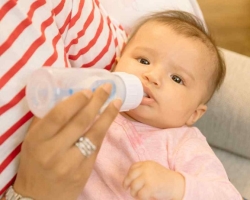You can be sure that nothing will happen to you. You can not read a bunch of information and not understand - what can happen and how can you help? Perhaps you are too lazy and you do not want to spend your precious time on this - this is your personal desire and it has the right to exist. But exactly until it concerns you.
If you have become parents, you are responsible for your child, his health and safety. Your parent’s duty is to know how to be able to provide urgent medical care to your child in an emergency!
Content
- What is aid help, and how to understand when it is necessary?
- What can happen to the child and how to help him?
- Features of the algorithm for the provision of emergency medical medical
- First aid with the obstruction of the respiratory tract. Cardon and pulmonary resuscitation
- Video: What to do if the child choked. Emergency help techniques
- Reception of Gamlich. Podiathaifragmatic impetus in the stomach
- Providing emergency assistance to children with bronchial asthma
- The first aid algorithms for children in injuries
- First aid to children for bruises
- First aid for bruises of the head in a child
- First aid to the child for stretching and fracture
- First aid to children for bleeding
- The first emergency care for nasal bleeding in children
- First aid for poisoning
- First urgent help to the child with burns
- First aid when frostbite in the child of cheeks, face, arms and legs
- First aid to the child with electric shock
- Providing emergency care for seizures in children
- Help for a child with thermal and sunny blows
- Providing emergency assistance to children with anaphylactic shock
- Emergency pre -medical assistance to children: tips and reviews
- Video: How to make artificial respiration to an adult and baby?
 What is aid help, and how to understand when it is necessary?
What is aid help, and how to understand when it is necessary?
What is an urgent pre -medical care?
Warm assistance - a set of simple urgent measures aimed at saving a person’s life, as well as to prevent possible complications, if there is an accident or disease.
Unfortunately, in your life you will more than once encounter the need to provide medical care to you or other people. And a situation will certainly arise when your child will need to help. It is possible that urgent help will be needed.
If something happens to your child, you, like any person who does not have a medical education, first call an ambulance. Because medical care should be provided by people who have appropriate education and permission to conduct the necessary manipulations.
They will evaluate the condition of the child and take the necessary measures. But the main question is when? When will the ambulance come? When will the doctors help? And will it not be too late? You cannot calmly wait for them and see that the condition of the child is deteriorating. And you have the opportunity to help here and now, only you need to know how!
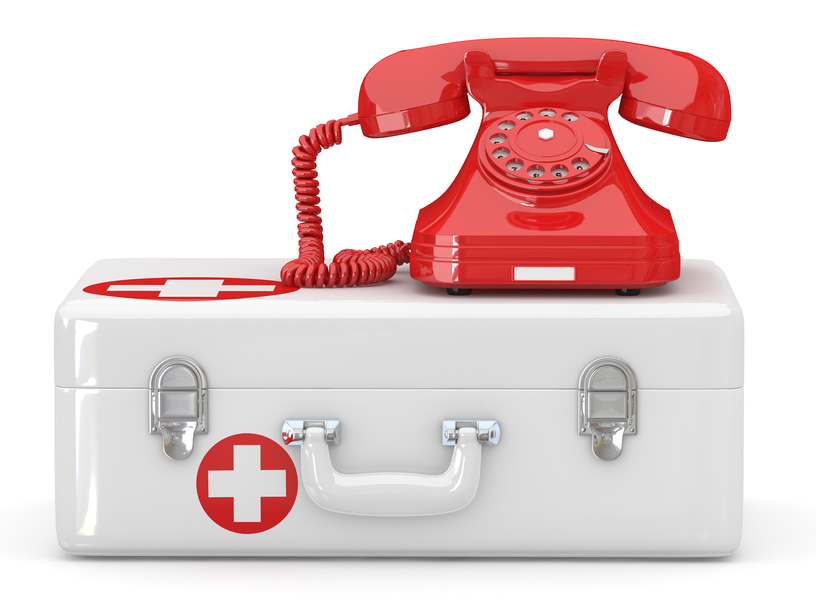 If something threatens the child’s life, then the situation is critical:
If something threatens the child’s life, then the situation is critical:
- the child is unconscious - does not respond to touch and your words
- the child has no breath - the chest does not move, it is not heard how it breathes, breathing is not felt on your cheek
- there is no pulse on sleepy, shoulder, radiation and femoral arteries
- the pupils are expanded and do not react to light
- the skin is pale or with a bluish tint
If the situation is critical, you need to urgently take measures!
What can happen to the child and how to help him?
From birth to 6 months, when the child turns over and reaches for all pens, the following accidents occur:
- the child is injured in his crib or when he tries to get out of it
- children often fall from a changing table
- kids receive burns about hot coffee or tea
- children are injured in accidents, because The children's car seat is not operated incorrectly or it is not at all
Children from 6 months to a year, are already crawling and taking the first steps:
- injured by children's toys: cut on sharp edges, swallow small details
- fall from a chair for food
- fight on sharp corners of furniture
- get burns from cigarettes
- injured when hot objects, sharp knives or fragments of dishes are grabbed
- fall out of stroller or walkers
- injured in car accident
Children from year to two, everywhere go and are interested in everyone:
- fall from a height to which they climbed
- are poisoned by harmful substances that eat
- injured in the study of their home: overturn cabinets, eat medicine from the first -aid kit
- drown or choking in water: bath, pool, pond
- get cuts
- injured in car accident
The child receives most injuries at home, so your task is to provide him with a safe environment. Everything that the child can get should be as safe as possible for him.
Of course, it is impossible to remove everything - you need to teach a child that certain things cannot be touched.
Features of the algorithm for the provision of emergency medical medical
- Assess the situation, understand what happened and what is the cause of the accident. It can be an electric current, fire, fallen furniture or other items
- Call an ambulance, call for help
- Stop this reason, and be sure to follow your safety-if something happens to you, you cannot help your child
- Try to remember how you can help the child, depending on the nature of the injury
- First aid provision: stop bleeding, do artificial respiration, indirect heart massage, apply a bandage
- If you have the opportunity to deliver the child to a medical institution as soon as possible or wait for the ambulance
- Patch of emergency care
 Tools and dressing materialswhich should be in your first -aid kit:
Tools and dressing materialswhich should be in your first -aid kit:
- scissors
- safety pin
- long tweezers
- disposable gloves
- disposable syringes of different volumes
- liquid soap
- individual cooling bag
- the refrigerant
- bints: - gauze of different widths, elastic - tubular bandage: No. 1. Finger, No. 2. Hand, No. 3 head
- heblyer: -Rolling (fabric) -bactericidal (set -water -resistant)
- individual dressing bag
- medical dressing scarf
And such medicines:
- 1.5% solution of iodine for processing scratches, cuts, edges of the wounds and tools
- antiseptic, aerosol is most convenient for all
- antibacterial ointment for burns and animal bites
- burns remedy, preferably aerosol
- oral rehydration tool
- activated carbon
- antipyretic - in syrup for quick action and in candles with vomiting
- local anti -allergic agent for insect bites, allergic reaction, contact with toxic plants
- antiallergic agent inside, also plus medicinal and food allergies
- vasocusing drops
- candles with glycerin
- eye antiseptic, if something hit with eye injuries
Emergency care products for acute allergic reactions (Sold according to the recipe):
- hormonal anti -inflammatory drug - dexamethason (2 ml ‹30kg weight‹ 3 ml)
- adrenaline (anti-allergic agent): children under 6 years old-0.15 ml, 6-12 years old-0.25 ml, older than 12 years-0.5 ml.
Also in the first-aid kit there should be drugs that your family uses if there are some chronic and other diseases.
First aid with the obstruction of the respiratory tract. Cardon and pulmonary resuscitation
One of the most common causes of death in childhood is the overlap of the respiratory tract. When this happens, the child is trying to drag the air with all his might. If the child coughs, then he choked on something and the respiratory tract is partially blocked. At the same time, he can speak, cry and most importantly breathe.
To eliminate a foreign body, often enough cough and vomiting reflex that will occur in a child. In this case, it is better for parents to do nothing, you can only interfere and harm, let the child try to cope himself. Just stay nearby and try to emotionally support the baby so that he does not start panic, but calm down.
Do not climb into your child’s mouth and do not try to get an extraneous object to the touch - you can push it further!
When to act?
- the child is trying to grab air
- the skin of the child began to blue
- he loses consciousness
- the child shows that he choked: his mouth was open, his eyes are rounded, increased salivation, and he is frightened
- older children show that they choked on the throat
If you see one or more of the above signs in the child, you need to act. There are two approaches that you can apply.
Back blows that combine with shocks in the chest
This approach is intended for children under a year.
Try to help the child first yourself, do all the manipulations, and then call an ambulance. Simultaneously with the actions of salvation, call for help, even if you are alone, perhaps someone will hear and be able to call rescuers.
The compression of the chest. If, after hitting the back, the child did not begin to cry or cough, i.e. He did not begin to breathe and the object had not yet come out, turn the child up his face, in the same position, put him on his knee upside down. Press four times on the chest in the center in a place, lower than the middle between the nipples. Press with two or three fingers, lowering the sternum 4 cm and taking a break so that it return to its former place. Make the first and second item alternately until an extraneous item comes out, or until the child loses consciousness. In the second case, blows on the back cannot be done, you need to do indirect heart massage. 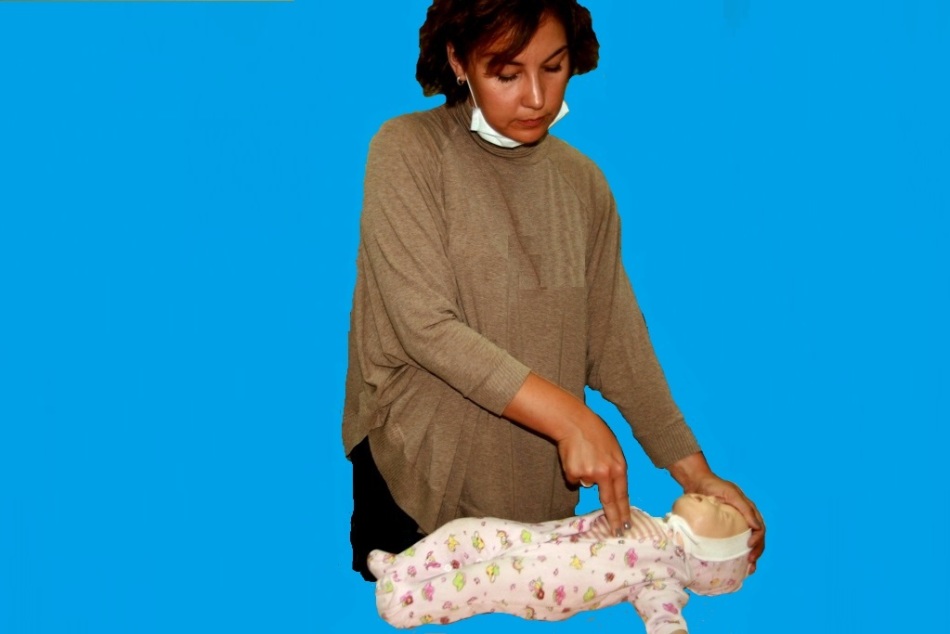 Look into the mouth and find an extraneous object. If the child is unconscious and you make him a heart massage for more than 30 seconds, look into his mouth and look for a foreign body. If you found it, get it.
Look into the mouth and find an extraneous object. If the child is unconscious and you make him a heart massage for more than 30 seconds, look into his mouth and look for a foreign body. If you found it, get it.
Breathing mouth in the mouth. If your child is still not breathing, do artificial lung ventilation. To do this, make 2 exhalations in the mouth or mouth in the nose and mouth. If the chest lifts when blowing air, then the respiratory tract is clean. Continue to do artificial respiration until the child begins to breathe. If the child’s chest does not rise with artificial ventilation of the lungs, press your mouth more to the child’s mouth and make two more exhalations.
Repeat 2, 3 and 4 points from the beginning.Alternate an indirect heart massage for 30 seconds with two exhalations of artificial respiration and checking the oral cavity before the arrival of doctors.
Video: What to do if the child choked. Emergency help techniques
If two minutes have passed, cardiovascular resuscitation does not help and no one has called rescuers yet, leave the child and call an ambulance.
Five strikes on the back. Put your child down face so that his body lay down on your forearm and tilt his head below the body. Catch your palm between the shoulder blades - the blows should be strong and fast.
 Reception of Gamlich. Podiathaifragmatic impetus in the stomach
Reception of Gamlich. Podiathaifragmatic impetus in the stomach
This technique is carried out with children older than a year.
It can only be done if The child is conscious. Go to him from behind, take your hands behind his waist. Clutch one hand in a fist and put a fist on the child’s stomach with a thumb with a thumb is slightly higher than the navel. Clutch your fist with the second hand and sharply press deep into the abdomen, repeat such shocks 6-10 times. Carefully make sure that your hands do not touch the ribs and infants of the child. Continue resuscitation until an extraneous subject comes out or until the child loses consciousness. In the second case, carry out cardiac resuscitation described in the previous section: indirect heart massage and artificial respiration.
 Providing emergency assistance to children with bronchial asthma
Providing emergency assistance to children with bronchial asthma
Bronchial asthma is now a fairly common disease in children. Exacerbation of this disease provokes
- untimely and incorrect treatment
- contact with allergens
- canceling or reducing dosage of drugs
- bronchial infection
- acute respiratory disease
- the emergence of a serious source of environmental pollution

The main symptom of the disease is attacks of suffocation. The harbingers can manifest themselves with a sensation of itching, burning in the throat, paroxysmal cough, sneezing.
In the midst of asthma, there is:
- dry cough
- dyspnea
- the breath is short
- it’s difficult to exhale, accompanied by whistling hoarses
Attacks of bronchial asthma are often removed by inhalations with through a nebulizer. The following bronchospasmolytics are used for this: Berodual and Ventolin.
These drugs are used in combination with mucolytic agents - acetylcystein, Ambroxol, carbocystein, which help children to jerk sputum, because reduce its viscosity.
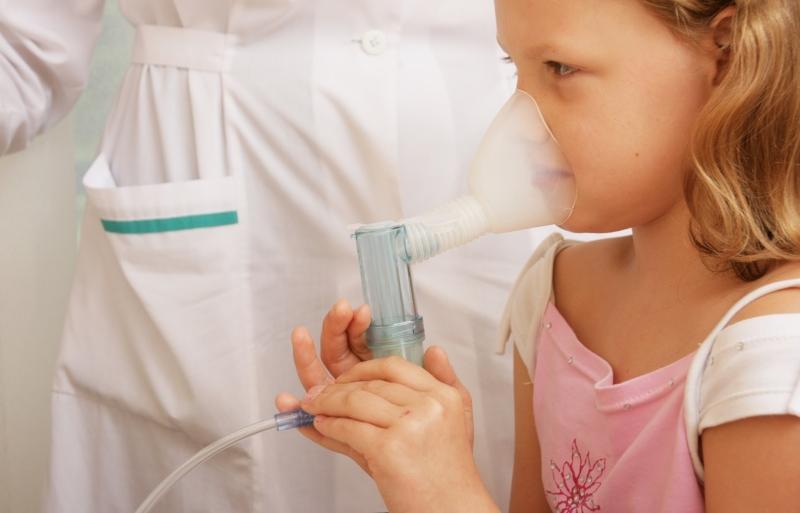
- Vegetolin is produced in non -bells of 2.5 ml. A single dose with a slight attack is 0.02 ml per 1 kg of a child, with an average of 0.03 ml/kg, with a heavy - 0.03 ml/kg every 20 minutes
- Berodual is prescribed up to 6 years-0.5 ml, from 6 to 14 years-0.5-1 ml
- Ventolin and Berodual for inhalations are divorced in 2-4 ml of physiological solution
Children with severe attacks of bronchial asthma should receive treatment in a hospital.
The first aid algorithms for children in injuries
Injury Damage to tissues and organs is considered, which is caused by any environmental factors: physical, thermal, chemical, mechanical.
There are injuries:
- various severity of damage
- c and without bleeding
What first aid will be on these characteristics.
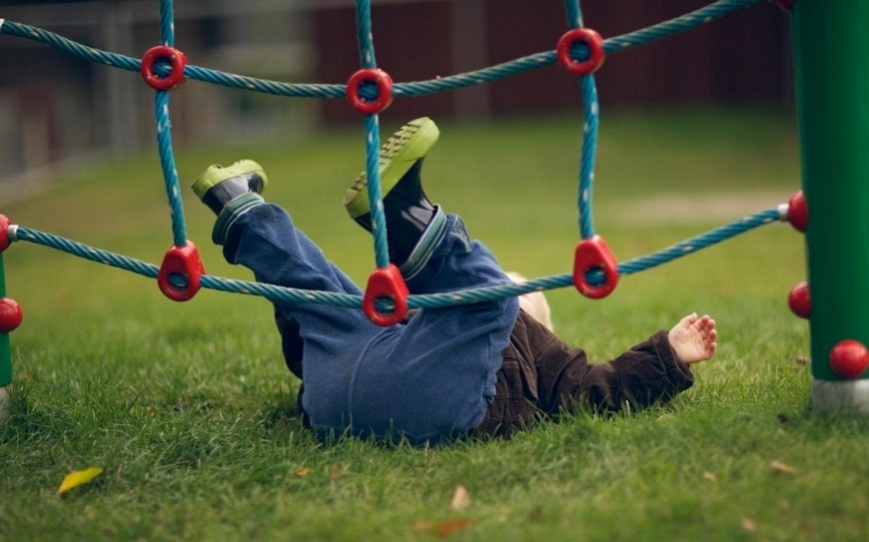 Injury - This is such an injury, in the event of which the integrity of the skin is not violated. Often a bruise occurs when stupid objects or when falling.
Injury - This is such an injury, in the event of which the integrity of the skin is not violated. Often a bruise occurs when stupid objects or when falling.
Symptoms bruise:
- pain in the place of damage
- swelling of this place
- changing the color of the skin
Despite the fact that the bruise seems frivolous, severe damage to organs such as spleen, brain, liver, kidneys can be hidden under it. Therefore, after the injury, carefully observe the child, and if something is wrong, immediately go to the hospital.
 First aid.
First aid.
- Provide the child and damaged place. Try to talk with the child calmly so that he calms down and relax
- Attach the cold to the damaged area - this will reduce the pain, reduce swelling and stop hemorrhages in the tissues. Do not press much, because This, on the contrary, will strengthen the pain. Keep the cold for up to half an hour, if necessary, wait 10 minutes and repeat the procedure
- If the arm or leg is damaged, put it slightly above the child’s body.
- If you do not observe signs of a fracture, i.e. injury is not serious, you may not resort to medical care
- However, be sure to watch your child for some time.
- If you still suspected the presence of a fracture, injuries of internal organs or brain, urgently consult a specialists
- When providing emergency care for bruises, in no case massage and do not rub the damaged area
First aid to children for bruises
Scratch It is damage to the upper layer of the linear skin. Scratches usually appear from branches of trees, shrubs, pets.
Abrasion - Damage to a larger area is often on the knees and elbows after falling.
Cuts - This is a stronger and deeper damage that injures all layers of the skin and can affect soft tissues.
Bruises Damage the skin, soft tissues and can touch the muscles.
With the above damage, the following first aid must be provided:
- clean the wound, rinse it under a stream of water, preferably with baby soap
- treat the wound with hydrogen peroxide, do not use iodine for this
- if there is bleeding, you need to stop it by laying a pressure dressing
- if the bleeding is not strong and quickly stopped, treat the wound with an antiseptic on water -based
- if the bleeding is strong, apply a tourniquet and bring the child to the hospital
- if you think that the wound is serious and you will need to impose the seams, do not hesitate, consult a doctor, because After 8 hours, the wound will be infected and it will not be possible to sew up
- if there is an extraneous item in the wound, do not take it out, this can provoke bleeding, apply a bandage and consult a specialist
- apply on the bruise and hold it for half an hour
 First aid for bruises of the head in a child
First aid for bruises of the head in a child
It is very important here to be able to distinguish between the skull injuries from brain damage. The child’s skull works like a helmet for the brain, and it itself is covered with skin, which is often injured. The scalp contains a lot of blood vessels, so when injuries, blood goes so strongly and cones grow quickly, but do not worry much, put ice and they will quickly pass.
The main danger with bruises of the child’s head is damage to the brain.
It can be of two types:
- brain concussion
- bleeding
Pay special attention to the chopped wounds of the child’s head. Outwardly, they look frivolous, but can damage the skull and cause inflammation of the brain.
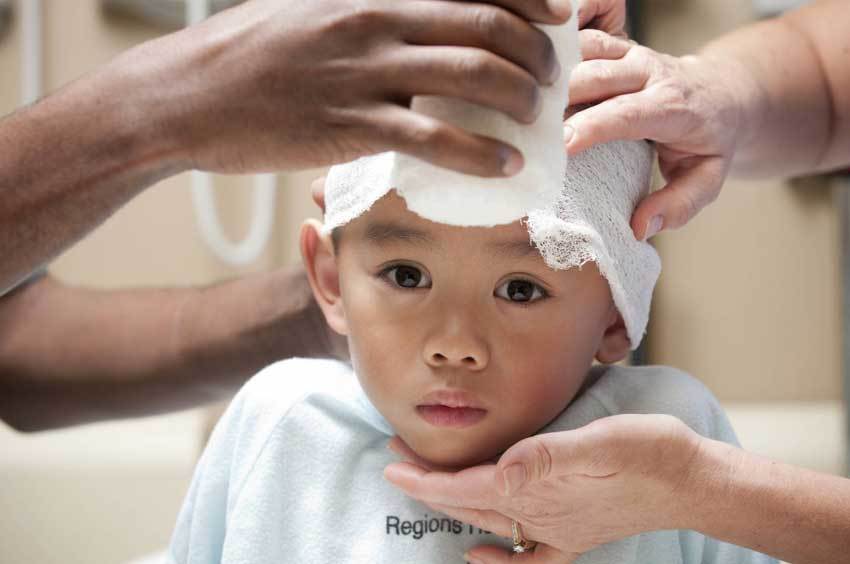 If your child has lost consciousness, check your breath. Doesn't breathe? Make cardiac intensive care. Breathing? Good. Look at the color of his skin, the lips are not blue? If not, put it evenly and call the doctors. If it seems to you that the neck is possible, do not touch the child, do not change his position - this should do a qualified medical staff. If the child began to cramps, observe his breathing ways so that nothing prevents him from breathing.
If your child has lost consciousness, check your breath. Doesn't breathe? Make cardiac intensive care. Breathing? Good. Look at the color of his skin, the lips are not blue? If not, put it evenly and call the doctors. If it seems to you that the neck is possible, do not touch the child, do not change his position - this should do a qualified medical staff. If the child began to cramps, observe his breathing ways so that nothing prevents him from breathing.
If the child is conscious, behaves normally, as before the fall, observe him and attach ice to the damaged area.
If your maternal intuition suggests that something is wrong, consult a doctor. It is better to play it safe than to miss the moment when you can help without consequences.
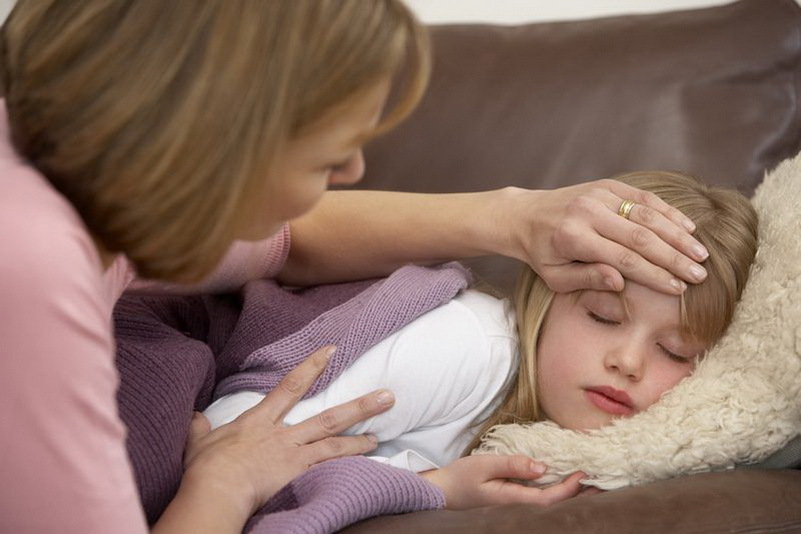 What you need to pay attention to and when to go to the hospital:
What you need to pay attention to and when to go to the hospital:
- the child is disoriented, loses balance
- can't wake up
- breathes strangely during sleep
- eyes mowed or pupils are dilated differently
- there is vomiting
- the skin turns pale
- blood or other liquid comes from the ears
- there are convulsions
First aid to the child for stretching and fracture
A fracture of bones can be determined by severe pain, the presence of a tumor, a limitation of mobility, an unnatural position of a broken limb. In young children, so -called breaks often occur. At the same time, the child can limp and cannot stand on a sore leg.
Your actions:
- attach the cold
- raise the damaged limb slightly higher, put it on the pillow
- fix the injury place, because Children can be uncontrollable due to pain and, moving, do even greater harm to themselves
- direct the child to the hospital or call an ambulance
 To fix the limb, the tire is best suited, instead you can use a stick, a rail, a board, a cane, an umbrella, etc. The tire must be attached to the limbs and fixed so as to immobilize the next 2 joints on both sides of the fracture. If the fracture is open, do not press the tire to it in any case.
To fix the limb, the tire is best suited, instead you can use a stick, a rail, a board, a cane, an umbrella, etc. The tire must be attached to the limbs and fixed so as to immobilize the next 2 joints on both sides of the fracture. If the fracture is open, do not press the tire to it in any case.
First aid to children for bleeding
In children, like adults, there is internal and external bleeding. In addition to blood loss, it is still dangerous by infection, so it must be quickly stopped. To do this, first you need to determine its intensity:
- with slight bleeding, rinse the wound and apply the bandage
- with more severe bleeding - apply a pressure dressing
- with very severe bleeding, when the blood beats with a “fountain”, it is necessary to apply a tourniquet
If damage to a small wound, the child needs to be washed with water and disinfected, for example, hydrogen peroxide, chlorhexidine, miramistin. In no case do not use iodine, because It will burn the damaged tissue, it is applied only to the edges of the wound to avoid infection.
- With severe bleeding, there is a risk of blood loss, so you need to apply a tight bandage
- If the bleeding continues, apply one more or two
- Usually more than three bandages are not required. Do not remove the bandage and hold on the child until the doctor arrives
- If blood goes on a “fountain”, immediately apply a tourniquet
- Before that, click the artery strongly pressing on its finger, if the child is not 2 years old, if the child is older, press the fist
- The tourniquet is applied either to the upper third of the hands, if the hand is damaged, or on the inguinal fold on the leg, if the wound on the leg
The tourniquet is always tied above the wounds, under it there should be thin fabric or clothes. If you did everything right, bleeding will stop right there.
 Keep the tourniquet on the body for up to 30 minutes in the winter and up to 60 minutes in the summer. If this is not enough, remove it for a couple of minutes and draw it again a little higher than last time. Do not forget to detect time, the doctor will definitely ask him.
Keep the tourniquet on the body for up to 30 minutes in the winter and up to 60 minutes in the summer. If this is not enough, remove it for a couple of minutes and draw it again a little higher than last time. Do not forget to detect time, the doctor will definitely ask him.
With bleeding, it is impossible:
- remove an extraneous object from the wound, if any, it needs to be fixed and covered with something
- bewildered
- touching an open wound is not in sterile gloves
- the tourniquet is used only when the blood goes "fountain"
The first emergency care for nasal bleeding in children
If the child has blood from the nose, sit it, tilt your head a little forward and squeeze the wings of the nose so that the blood does not flow anymore. You can put cold on the nose bridge.
When blood goes with a nose, it is forbidden to throw back the head, because Blood will flow into the esophagus and may cause vomiting.
Do not use cotton wool, because She will shuffle to the vessels in the nose and when you remove it, you can damage them and the bleeding will begin again. Usually it takes about 10-15 minutes to stop blood.
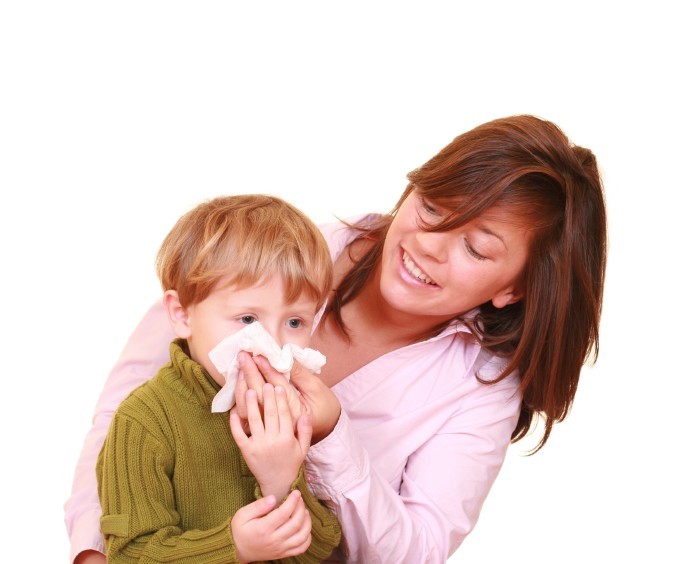 If this does not happen, see a doctor immediately, continue to pinch your nose and apply the cold to the nose.
If this does not happen, see a doctor immediately, continue to pinch your nose and apply the cold to the nose.
First aid for poisoning
Poisoning is an ingestion of the substances harmful to him. They can be swallowed, obtained through the respiratory tract or with skin contact.
Often, poisoning is accompanied only by disorder of the stomach, but there are rather serious cases, up to death.
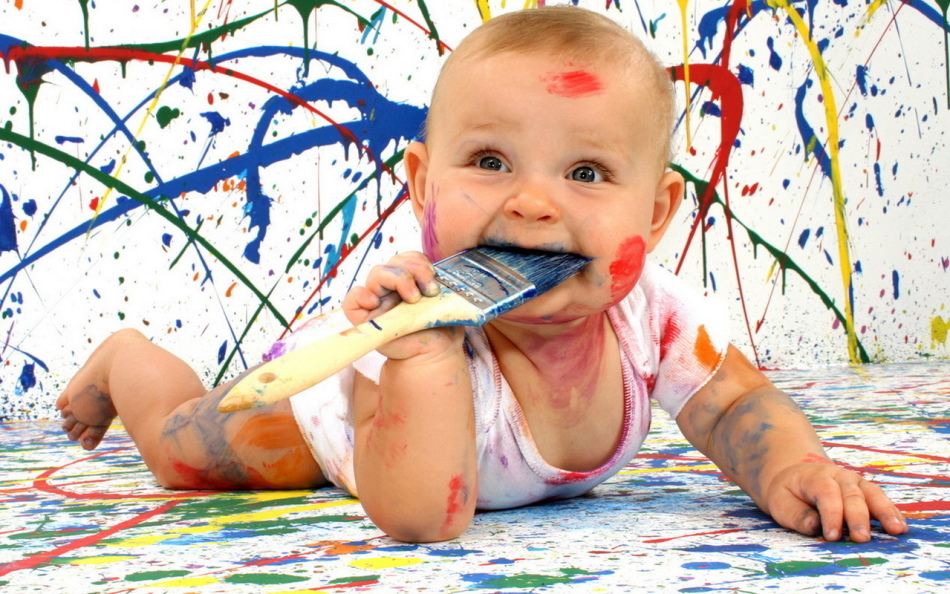 If you saw that your child has eaten something poisonous, immediately call an ambulance. Rescuers need to quickly provide the following information:
If you saw that your child has eaten something poisonous, immediately call an ambulance. Rescuers need to quickly provide the following information:
- what kind of poison it was, how many were swallowed
- when this happened, up to a minute
- the age of your child and his weight
- what are the symptoms
On the phone you will be consulted and tell you what to do before the arrival of doctors.
Not all poisons are excreted with vomiting, and some can harm the esophagus, so do not provoke vomiting in the child yourself.
It is impossible for the child to tear if the following substances enter the body:
- various polishes
- oil products: gasoline, turpentine, gasoline, kerosene
- chemicals such as acid, alkali, pipe cleaning tools
- detained substances such as chlorine or ammonia
Usually, experts recommend a lot of water or a cup of milk in such cases. But the health workers should be informed about this.
First urgent help to the child with burns
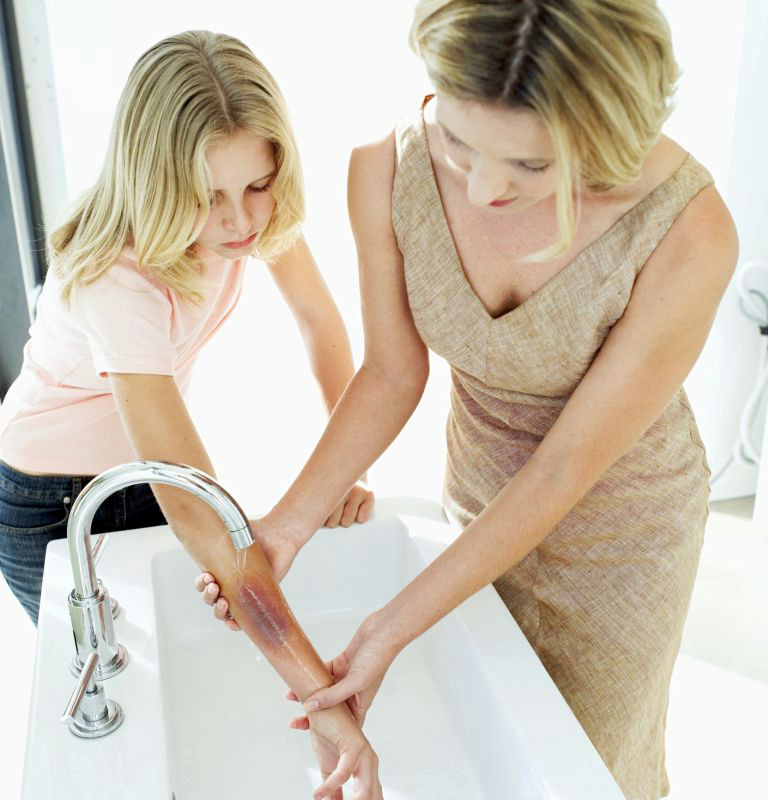 There are several degrees of severity of burns that depend on the soreness and magnitude of tissue damage:
There are several degrees of severity of burns that depend on the soreness and magnitude of tissue damage:
- Burns first degree They are manifested by redness of the skin, do not hurt much and to eliminate them, you need to hold the damaged area in cold water, smear with antiseptic cream or aerosol and wait a little time
- Burns second degree manifested by blisters and rejection of the damaged layer of the skin and strongly hurt
- Burns third degree struck rather deeper layers of the skin
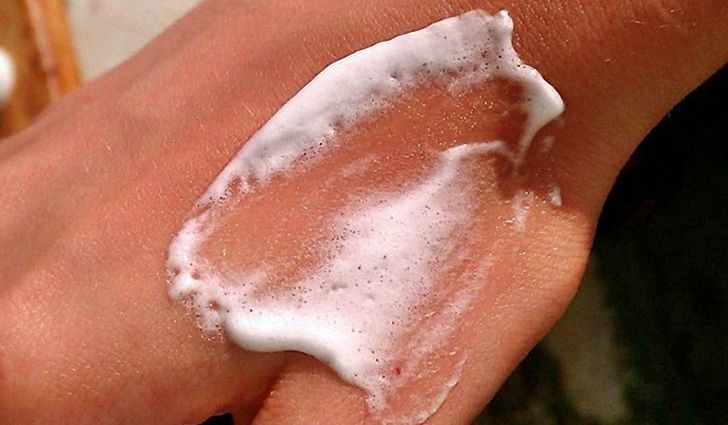 Your actions:
Your actions:
- If clothes are burning, put out her with something like a bedspread or other clothes
- Remove your clothes hot from fire or boiling water, do not burn the child in another place, cut it out if you need it
- Evaluate how serious everything is
- Place the damaged place in cold water for at least 20 minutes. Do not use ice, it will damage the sore skin even more. Do not smear the burn with oil or other fat
- If blisters appear, the skin turned white or blackened, anoint it with an antiseptic and close it with a clean cloth or bandage, do not press it much. Take the child to the hospital or call emergency assistance
- Give the child an antipyretic
With electric burnersemergency medical care is needed and most often the resuscitation of the victim. They are dangerous to violation of the rhythm of the heartbeat.
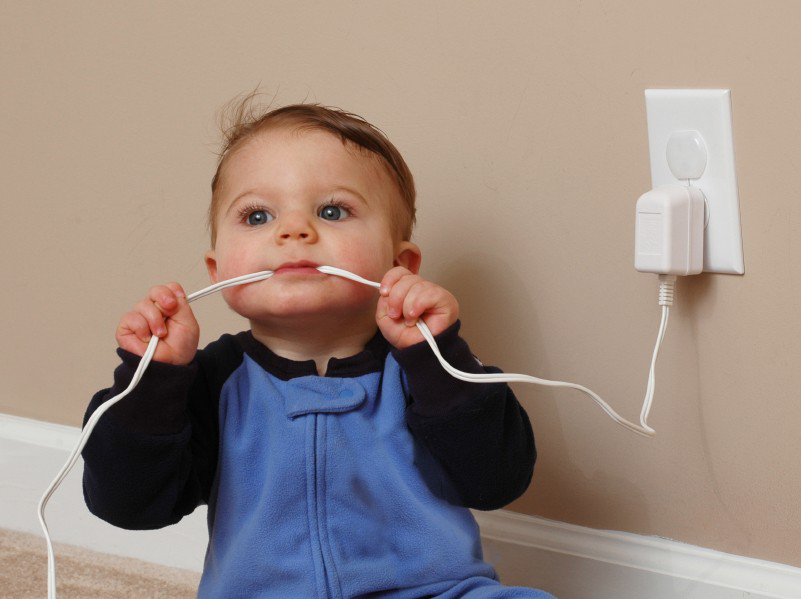 At chemical burnstake off damaged clothes carefully from the child, substitute the place of burn under cold water. If this substance enters the body, see the first aid section for poisoning. If the substance fell into the eyes, it is urgent to rinse them under a stream of water for 20 minutes.
At chemical burnstake off damaged clothes carefully from the child, substitute the place of burn under cold water. If this substance enters the body, see the first aid section for poisoning. If the substance fell into the eyes, it is urgent to rinse them under a stream of water for 20 minutes.
At sunburn Cool the damaged place with cold compresses or water, anoint with ointment from burns, for example, panthenol.
First aid when frostbite in the child of cheeks, face, arms and legs
Frostbite in children occurs due to low temperatures (enough and -10 aboutC), as a result of which parts of the body are damaged or tissue even die off.
There are several degrees of frostbite:
- The first degree - The damaged area turns pale, and if it is heated, it becomes red and swells. Demetment does not occur and in a week everything goes away
- The second degree - The damaged place is pale, there is no sensitivity, blisters appear, itching and pain appear. Recovery takes up to two weeks
- The third degree - Bubbles on the affected area are bloody, there is no sensitivity, severe pain. The skin cells die, scars form. After 2-3 weeks, the damaged tissue is rejected
- The fourth degree - frozen skin is blue and has marble color. If you warm, swelling appears, there are no bubbles, there is no sensitivity. There is a damage to joints, bones, necrosis of the soft tissues
 Basic measures when frostbite:
Basic measures when frostbite:
- take the child to heat
- undress
- assess the degree of frostbite if damage to the second, third or fourth degree - immediately cause an ambulance.
- at frostbite of the first degree Warm up damaged areas, you can make baths with potassium permanganate or furatsiline, first make them with a temperature of about 25 aboutC and in half an hour bring to 37-39 aboutFROM
- you can warm the frostbitten skin with breathing, grind with natural warm cloth, massage slightly, then wrap a cotton-gauze bandage
- at frostbite of the second, third and fourth degreewhile you are waiting for doctors, apply a bandage that retains heat, it is made from such layers: gauze+cotton+another layer of gauze+film
- fix the damaged place with a cardboard on the top of the bandage, wrap it in wool, let the child drink hot and let the analgin accept
Remember: when frostbite, rapid heating and rubbing with snow is strictly prohibited. With severe damage, do not rub oil, fat or alcohol!
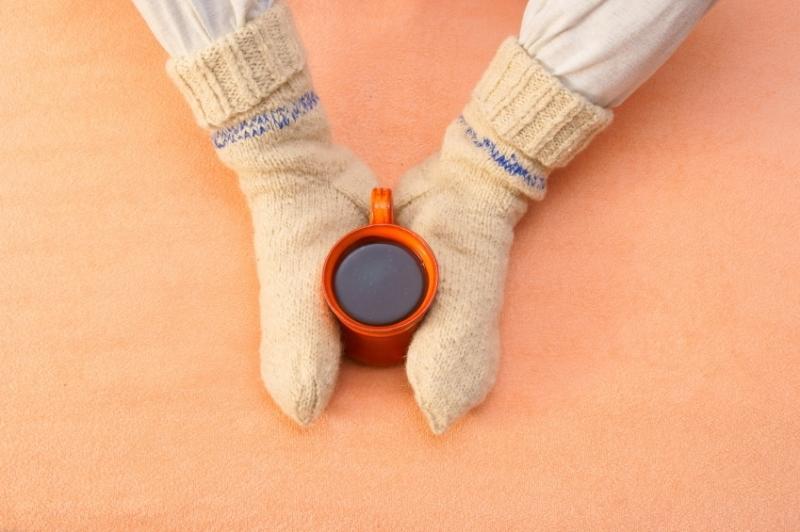 Fricure of the cheeks is characterized by a pale skin color, on which red spots and swelling occur. After a couple of days, the color can change to cyanotic, which will then become green and yellow. Apply ointment to frostbitten cheeks, for example, a rescuer, Bepanten or Traumel. If you go out with your child in the cold, be sure to lubricate your face with a special cream that protects against frost.
Fricure of the cheeks is characterized by a pale skin color, on which red spots and swelling occur. After a couple of days, the color can change to cyanotic, which will then become green and yellow. Apply ointment to frostbitten cheeks, for example, a rescuer, Bepanten or Traumel. If you go out with your child in the cold, be sure to lubricate your face with a special cream that protects against frost.
First aid to the child with electric shock
You probably have a bunch of electrical appliances at home, which are potentially dangerous when there is a small researcher in the house.
If you still did not keep track and the child got to a faulty wire or outlet, you immediately need to provide him with first aid:
- Disconnect the current source, if this is not possible, pull it from the child or vice versa, depending on the situation. But do not do it with your bare hands, you will also hit the current and you will not be able to help the child! Use a stick, a mop, folded with a newspaper, a rope, something rubber, in general, that does not conduct electricity
- Check the child’s breathing, look at the color of his skin, does he have a reaction to external stimuli
- If there is no breathing, there is no heartbeat, urgently start the heart and pulmonary resuscitation (the description is in the corresponding section)
- Call for the rescue
- Do not move the child. The effect of an electric shock could damage the spine

- If the child is conscious and breathes, check the location of the shock, the skin may be burned out and you need to do a burn
- Contact your pediatrician. The electric current can harm the internal organs and the child must examine the doctor
Tip: To eliminate the current source, you can cut down all the electricity in the house, turning off the fuses on the counter. This is the most effective way, but only if you know where this counter is.
Provide the child with a safe territory for research:
- close all sockets with protection from children
- repair or throw out all broken electrical appliances
- replace shabby wires with new
- do not climb into the toster with a knife, and put wooden forceps near the toaster, just in case
Providing emergency care for seizures in children
In the brain, sometimes electric discharges of pathological origin occur, which become the causes of seizures.
A child during seizures can:
- fall to the floor
- ride on the floor
- foam is formed in the mouth
- roll eyes
- bite your tongue
- temporarily lose consciousness
 The task of the parents to ensure that the child’s breathing does not interfere, for example, a trampling tongue or discharge from the mouth.
The task of the parents to ensure that the child’s breathing does not interfere, for example, a trampling tongue or discharge from the mouth.
Often seizures occur with an increase in body temperature in a child. Attacks quickly pass and most often do not harm the body.
What needs to be done during cramps in a child:
- put it on the floor, turn your face to the side or down so that the discharge and tongue do not overlap the respiratory tract
- do not put anything in the child’s mouth, no food and drink, neither during the attack, nor some time after it
- do not hold back cramps
- do not worry if the lips are normal, then the child breathes and everything will be fine
- if the lips are still blue and there is no breath, clean the throat and make artificial breathing rot-v-west
- to avoid bruises on furniture, clear the space around
- Attacks can have a second wave to prevent it from put a candle of antipyretic, tear the baby, wipe it with warm water to reduce body temperature
- After seizures, children usually fall asleep tightly
- If your child’s seizures did not start from high temperature, urgently cause emergency assistance
Help for a child with thermal and sunny blows
The thermoregulation system in children does not work as in adults, so children often overheat. The heat can provoke a child with a thermal or sunny blow.
Remember: symptoms of thermal blow in children appear later than internal changes in the body, so noticing them very quickly!
Symptoms of thermal strike:
- the body temperature rises
- the skin is dry and hot
- the child almost does not sweat
- pulse and breathing quickens
- hallucinations, convulsions, delirium, violation of coordination, and even loss of consciousness are possible
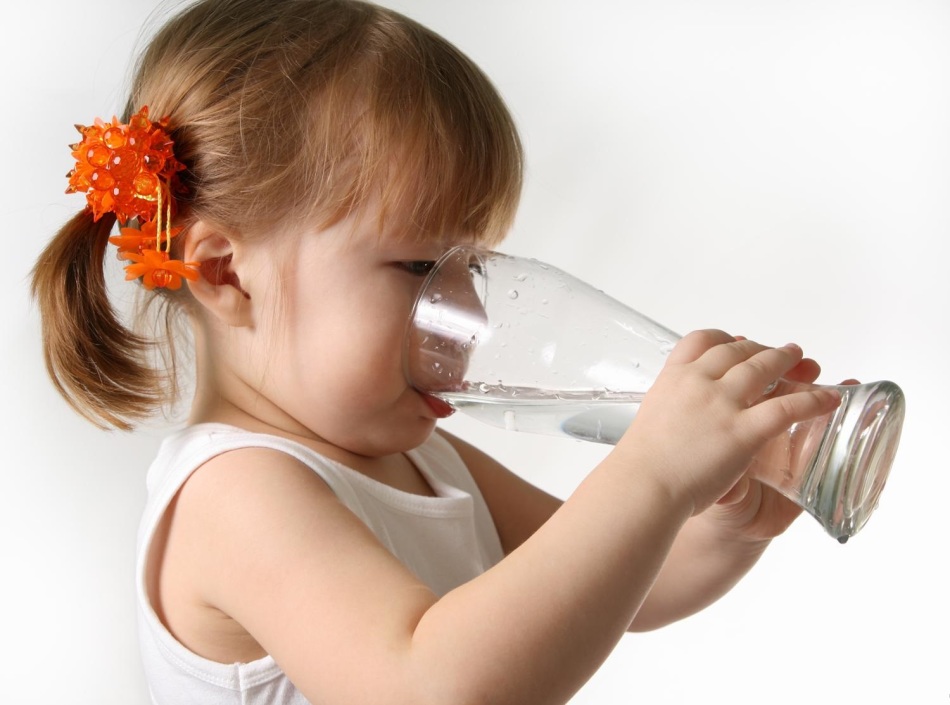 You must help your child immediately:
You must help your child immediately:
- reduce body temperature and cool it - make a cool bathroom or wrap the child with a wet sheet with a wet sheet
- dill the child, often and little by teaspoon, so as not to provoke vomiting and more severe dehydration
- as soon as possible, call the emergency help or take it to the hospital.
Providing emergency assistance to children with anaphylactic shock
 Anaphylactic shock is an allergic reaction that most often occurs when the child is administered or insect bites. This reaction develops very quickly and is very manifested. The anaphylactic shock suddenly begins - the child turns pale, blows, shows anxiety and fear, shortness of breath appears, vomiting, the appearance of itching and rash is possible. The child begins to choke, cough, pain in the heart and headache appear. There is a sharp decrease in blood pressure and the child loses consciousness, convulsions appear, there is a probability of death.
Anaphylactic shock is an allergic reaction that most often occurs when the child is administered or insect bites. This reaction develops very quickly and is very manifested. The anaphylactic shock suddenly begins - the child turns pale, blows, shows anxiety and fear, shortness of breath appears, vomiting, the appearance of itching and rash is possible. The child begins to choke, cough, pain in the heart and headache appear. There is a sharp decrease in blood pressure and the child loses consciousness, convulsions appear, there is a probability of death.
First aid.Put urgently the child horizontally on the back, lift your legs up and put something. Turn your head on the side, put the lower jaw and make sure that the tongue does not sink and the child does not choke in the vomit.
If the allergen was introduced as an injection:
- urgently stop the introduction of an allergen
- make a few injections around the administration of 0.1% of the adrenaline rh in a dosage of 0.05-0.1 ml for each year of life, but not more than 1 ml
- attach ice to the place of introduction
- put the tourniquet above this place and hold for 30 minutes
If the allergen is buried in the nose or eyes, urgently rinse them under a stream of water.
If the allergen was eaten, you need to immediately rinse the stomach to the child, if it is possible to do this in his condition.
In the last two cases, you also need to make an injection of 0.1% of the rr. adrenaline intramuscularly and into the muscles of the bottom cavity of the mouth 3% of the prenisolone in a dosage of 5 mg/kg of weight.
You need to give the child antihistamines:
- 1% Dimedrol rrity in a dosage of 0.05 ml/kg of weight, but not more than 0.5 ml for children for the year and 1 ml older than the year
- 2% of the Suprastin district 0.1-0.15 ml/year of life
Expand the windows to act oxygen. Be sure to follow the pulse, blood pressure, breathing and call an ambulance!
 Emergency pre -medical assistance to children: tips and reviews
Emergency pre -medical assistance to children: tips and reviews
According to statistics, a third of accidents occur with children at home, so the main task of parents to ensure the safety of the house and prevent trouble.
We hope that after reading this article you can provide your child with first urgent help if he needs it.
Take care of your children!

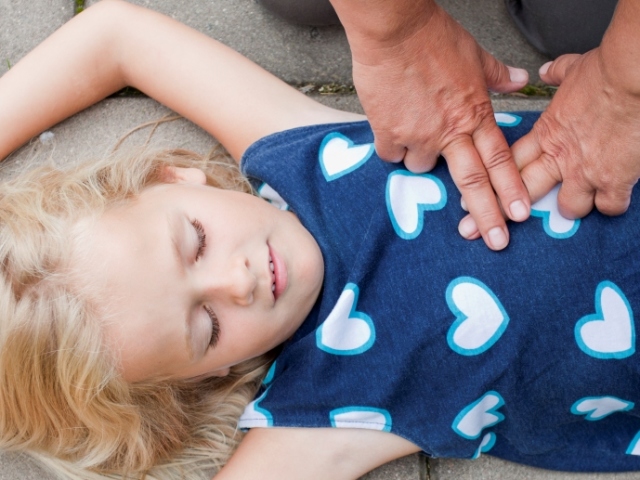
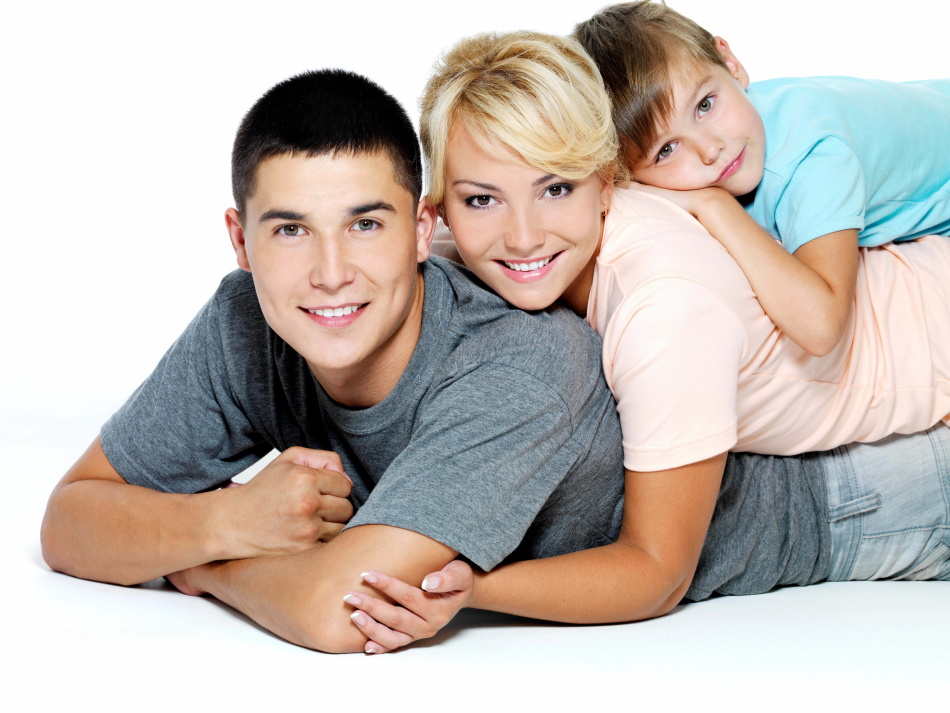

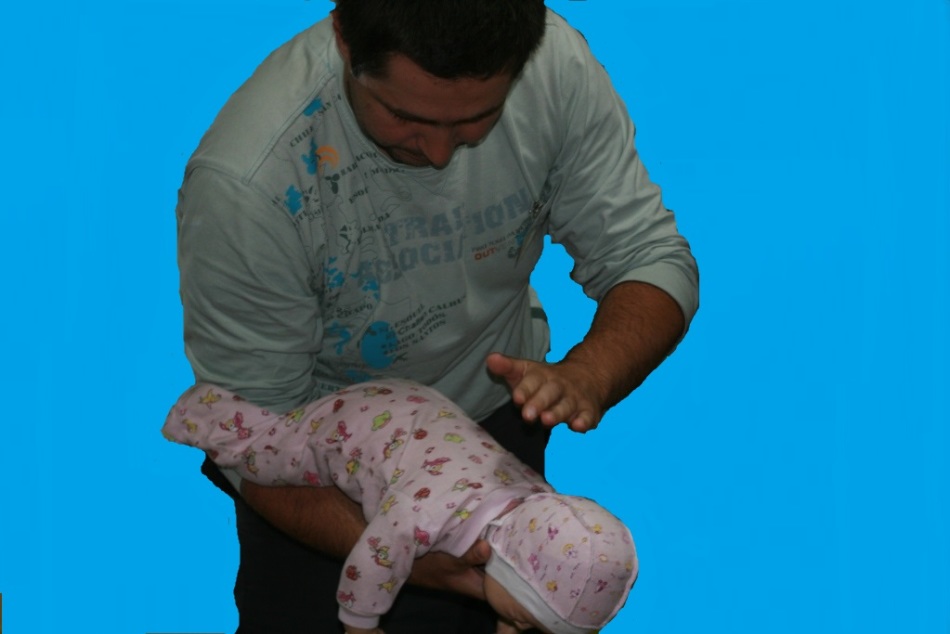
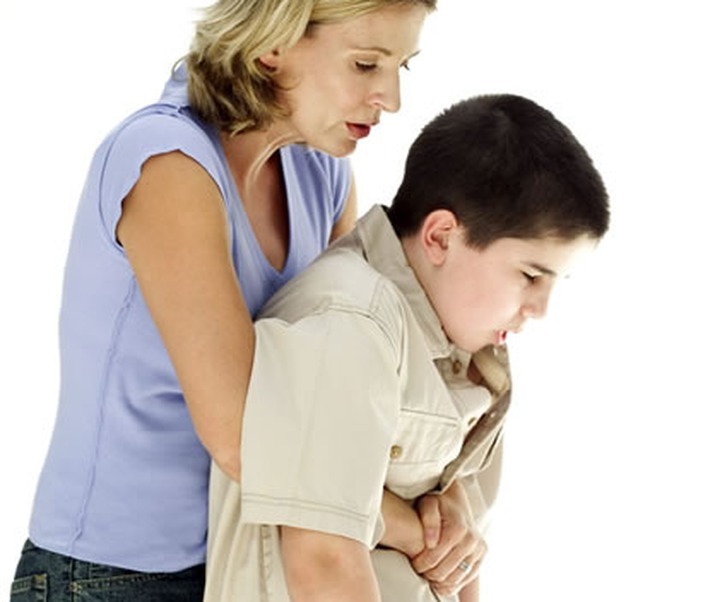 Providing emergency assistance to children with bronchial asthma
Providing emergency assistance to children with bronchial asthma
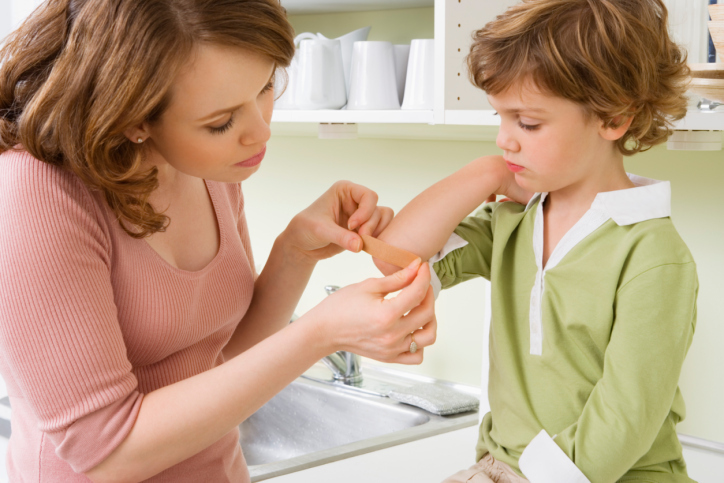 First aid for bruises of the head in a child
First aid for bruises of the head in a child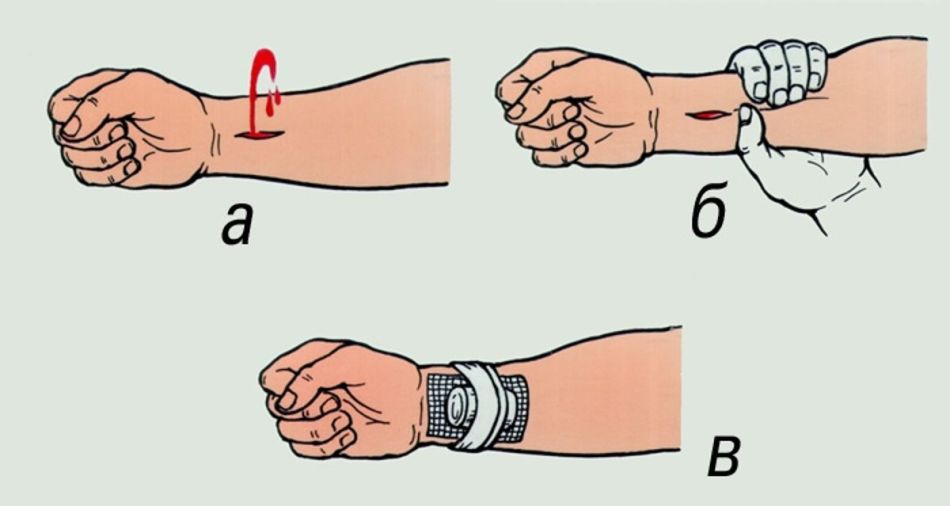
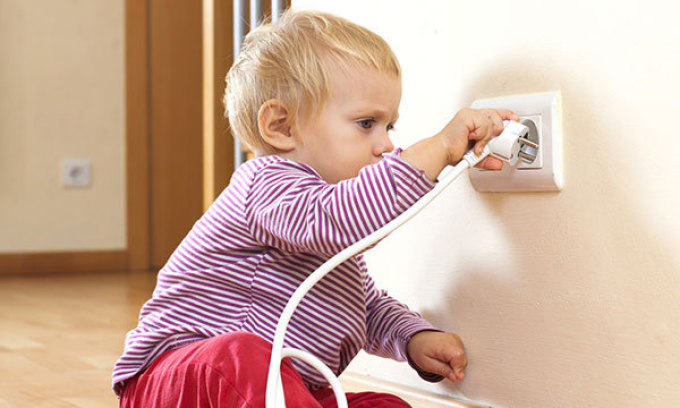

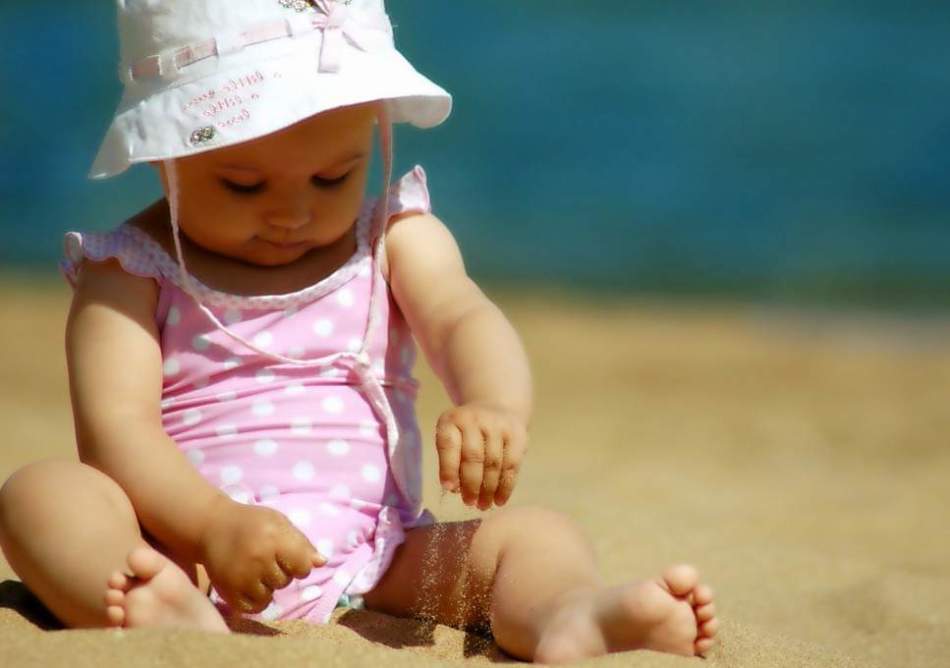
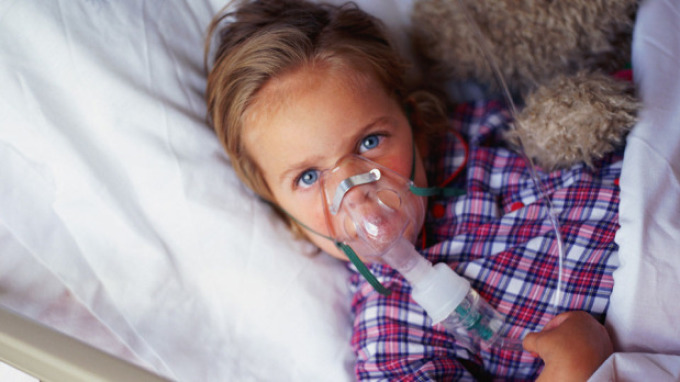 Emergency pre -medical assistance to children: tips and reviews
Emergency pre -medical assistance to children: tips and reviews



